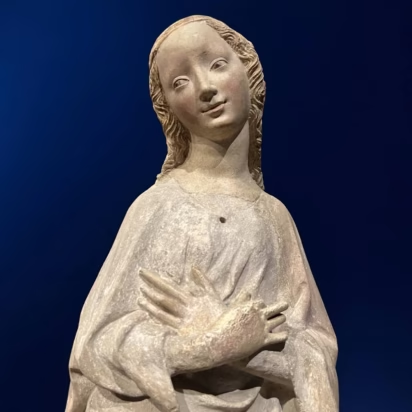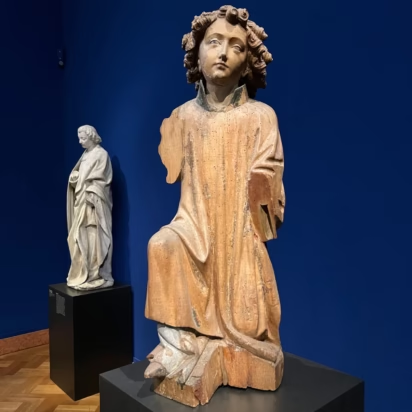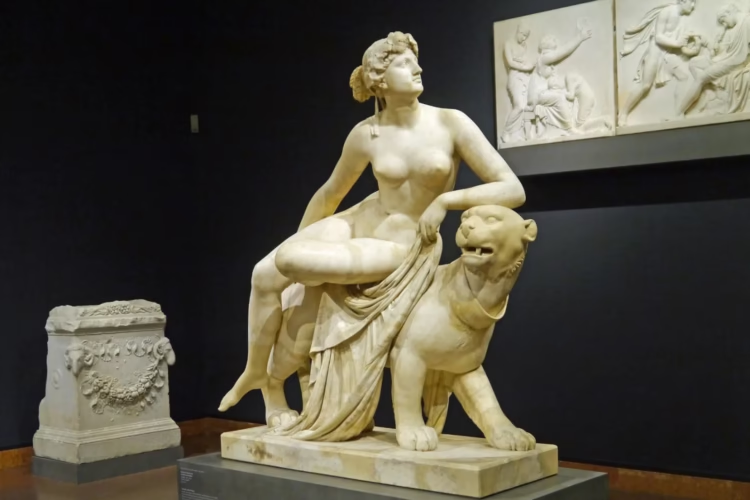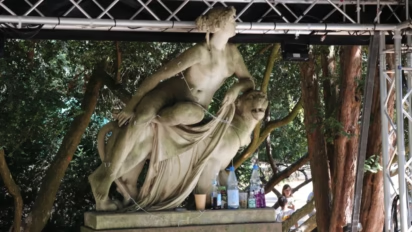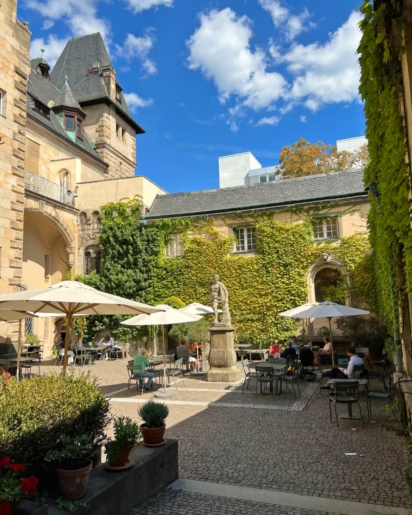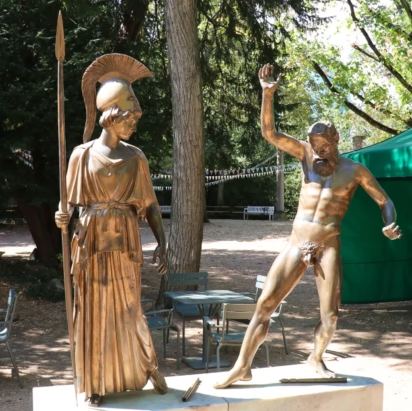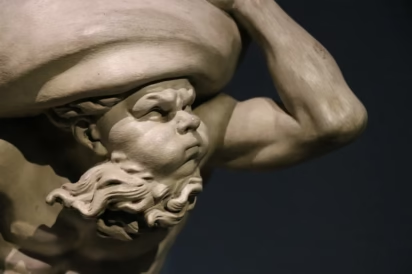The Liebieghaus Museum in Frankfurt am Main is home to a top sculpture collection (Skulpturensammlung) from antiquity to neoclassicism.

One of the finest sculpture collections in the world is in the small Liebieghaus Museum on the banks of the Main River in Frankfurt, Germany. Around 3,000 sculptures of exquisite quality are on permanent display with works spanning five millennia from antiquity to European neoclassicism. Famous works include Tilman Riemenschneider’s sandstone Virgin Mary (c. 1520), the terracotta altar by Andrea della Robbia (c. 1500), and Johann Heinrich von Dannecker’s Ariadne on the Panther (1803-14), while fine antiquities include Roman marble copies of the original Greek Myron Athena and the Discus Thrower by Naukydes.
Liebieghaus Museum Sculpture Collection in Frankfurt
The sculpture collection of the Liebieghaus Museum in Frankfurt has around 3,000 top-quality works on display spanning over 5,000 years of artistic achievement. The collection encompasses outstanding works from all eras from Ancient Egypt to Neoclassicism: with permanent exhibits from Egyptian, Greek, and Roman Antiquity, the Middle Ages and the Renaissance, Mannerism, the Baroque, and Rococo, Neoclassicism, and works from the Far East.
The Liebieghaus sculpture collection was founded in 1909 as a municipal museum without state support or being based on a princely collection like so many fine museums in Germany. Many of the other museums on Frankfurt’s Museumufer on the south bank of the Main River also remain dependent on the citizens of Frankfurt and generous donations.
The overriding principle of any work acquired and displayed by the Liebieghaus collection is the quality of the art. Rather uniquely for a municipal museum, any links to Frankfurt are purely coincidental — there is no focus on local artists or art that played a specific role in the region. Many donors are local but works may be sold to acquire new top-quality sculptures.
Sculpture Exhibitions in the Liebieghaus Museum in Frankfurt
The permanent exhibitions in the Liebieghaus Museum in Frankfurt are divided physically into the following sections that lead off the reception hall. Exhibitions may be seen in any order:
- European sculptures from the Middle Ages to Neoclassicism
- Sculptures from Antiquity
- Ivory Collection — currently in a large temporary exhibition in the basement
The museum has frequent temporary exhibitions — mostly in the basement but for smaller exhibitions a room of the permanent collection may be temporarily cleared to display something new.
Two sections of the museum may still be closed to visitors but it is always worth enquiring. The Studioli are rooms in the tower where the original living rooms were preserved with furniture and art. The Schaudepot (open depot) is filled with unlabeled works in storage — these are grouped for conservation purposes mainly by size and material rather than genre or period, so an Egyptian bust may sit comfortably next to a Rococo angel.
European Sculptures in the Liebieghaus in Frankfurt




The European sculptures exhibition ranges from medieval Gothic to Neoclassicism with special displays of the Renaissance, Mannerism, Baroque, and Rococo. The three most famous sculptures are possibly Tilman Riemenschneider’s sandstone Virgin Mary (c. 1520), the terracotta altar by Andrea della Robbia (c. 1500), and Johann Heinrich von Dannecker’s Ariadne on the Panther but the quality of other sculptures is top notch too.



As with any medieval art collection, religious themes dominate. It is interesting to study the strong emotions shown by the madonna and child sculptures — visitors may study them close up while many were originally placed much further away from the viewer as parts of altars or wall decorations. An interesting facial expression by Mary, Christ, or an angel seems to be a requirement to get displayed here.

A highlight of the late medieval period is the Rimini Altar (around 1430) in alabaster which includes twelve apostle figures and a crucifixion ensemble of several figures. Current research hints at Flemish artists but the alabaster was sourced from the Steigerwald (between Würzburg and Nürnberg) in Germany. As with sculptures from antiquity, medieval works were also painted and a few examples of what the painted alabaster works could have looked like may also be on display.
The great woodcarving master Tilman Riemenschneider was one of the first major artists to present large works unpainted — a gain for the buyer too, as painters were usually paid more than sculptures. His only work in the Liebieghaus is the Virgin Mary (ca. 1520) a sandstone sculpture, a medium he was also pretty good at. Some of Riemenschneider’s finest wood-carved altars may be seen along the Romantic Road to the southeast of Frankfurt in towns such as Creglingen and Rothenburg ob der Tauber.



Religious themes remain important in the Renaissance but more works inspired by antiquity and mythology are also produced. The small bronze Apollo Belvedere (ca. 1497) by Pier Jacopo Alari Bonacolsi, or Antico, is a highlight in the Renaissance exhibition. It was inspired by the large Apollo Belvedere marble sculpture which was discovered a decade earlier in Rome.
Other mid-16th-century small bronzes from Italy include Samson Slaying the Philistine and The Callipygian Venus. From the same period is a rare surviving wax Hercules.



Another noteworthy bronze in the Liebieghaus is the Black Venus (ca. 1600) by Barthélemy Prieur. This French mannerist artist was the court sculptor of Henri IV but this small bronze is more important than all his larger works. It is considered the first use of a black woman to portray the ideal of female beauty in a European sculpture.
The lead-tin alloy Apollo (ca. 1725) by Georg Raphael Donner is a late Baroque work inspired by an earlier work that also included a cupid. This Apollo shows the organic movement of sculptures that would be particularly popular in the Rococo.
The few works from the Rococo, a style particularly popular in southern Germany and Austria, show a new willingness to use bright colors, exaggerated gestures, and almost an attempt to paint with sculptures.
Dannecker’s Ariadne on the Panther
The Liebieghaus’ most famous sculpture is Johann Heinrich von Dannecker’s marble Ariadne on the Panther (1803-14 in Stuttgart). In contrast to other statues in the Liebieghaus, this one actually has a strong Frankfurt connection.
In 1810 the Ariadne statue was sold to the Frankfurt banker Simon Moritz von Bethmann (1768–1826) and from 1816 it was displayed in the Odeon, the first museum in Frankfurt open to the public. From 1856 onwards it stood in the specially built “Ariadneum” and was donated with the rest of this collection to the city of Frankfurt in 1941. Severely damaged by fire in 1943, Ariadne was encased in plaster and only released again in 1977 when the over thousand pieces were cleaned and reassembled.
The marble original is currently displayed in the antiquities section of the Liebieghaus — a compliment that probably would have appealed to Dannecker.
A bronze copy may be seen for free in the garden, or apparently, in James Bond’s Never Say Never Again — at 7 minutes and 25 seconds the sculpture is cited as an educational asset.
Sculptures from Antiquity in the Liebieghaus Museum in Frankfurt



The sculptures from antiquity in the Liebieghaus museum are also of exceptional quality or importance while research on the use of color on sculptures from antiquity is an ongoing interest.
The oldest sculptures in the museum are from Mesopotamia (3rd century BC) and ancient Egypt. The small bronze “Kouros” statuette of a young man is from Greco-Sicily, ca. 480 BC, placed one leg in front of the other — typical of the transition from the archaic to the classic period.



The classic Greek and Roman marbles are among the highlights of the collection. The most praised work is the Myron Athena — a very well-preserved marble Roman copy made around the time of the birth of Christ after a bronze statue (since lost) by the Greek sculptor Myron (ca. 450 BC). A second Athena marble is partly from around AD180 (torso, but with “supplementations of the Renaissance and Baroque”).



Another full-size marble is also a Roman copy of the Discus Thrower by the classical Greek sculptor Naukydes, ca. 390 BC. This is one of the few large Roman sculptures known during the early Renaissance. The Roman owner knocked the head off when the Spanish king tried to acquire the work. The head and right hand were later replaced. At times, this statue was considered a depiction of the young Hyakinthos that was loved by Apollo. While practicing throwing the discus, the jealous god of the West wind deflected Apollo’s discus from its course to fatally wound Hyakinthos. (A bit like Ganymedes and Zeus but with a less happy ending.) Modern archaeologists generally interpret the sculpture as a depiction of a victorious athlete that had the right to erect a statue of himself.

Of the sarcophagi, the most impressive is the sarcophagus illustrating the myth of Athena, Marsyas, and Apollo (Rome, ca. AD200). Athena invents the aulos (double-reed flute) but playing it distorts her beauty. The satyr Marsyas found it, played it well but lost in a play-off against the god Apollo, and is skinned alive. (A satyr playing the aulos also featured in erotica from antiquity, e.g. in the Altes Museum in Berlin.)



Striking marble busts of Roman Emperors Augustus (after 27 BC) and Marcus Aurelius (after AD169) are amongst the highlights of the Roman work. A bust of Emperor Caligula — the “mad” one — is shown in full color. It is based on a bust found with traces of the original polychrome.
Colorful Antiquities in the Liebieghaus



The museum is a leading research institute and in recent years specialized in the study of the use of color on sculptures from antiquity. (A special exhibition by the museum, The Gods in Color, toured many cities in the world since 2003.)
Several copies of antique sculptures are on display painted as they were likely finished in antiquity. Special light effects are used to show how different designs and colors were possible as tastes changed. A beautiful colorful statue of Helen of Troy (updated in 2019) is accompanied by a quote from Euripides’ Helen: “If only I could shed my beauty and assume an uglier aspect – the way you would wipe color off a statue.” On the whole, modern tastes probably prefer classic white marble to the more kitschy-colored originals.
Ivory Sculpture in the Liebieghaus Museum in Frankfurt

The sculpture collection includes a large number of ivory works, which are displayed until January 2023 in the basement as the Splendid White exhibition. The collection is mostly Renaissance and Baroque works collected by Reiner Winkler (1925–2020) and many items are likely to remain on permanent display. These works are obviously historical art.


Masterpieces in this collection include “Fury on a Charging Horse” (1610), “The Three Parcae” (ca. 1670), “Chronos on the Globe” (ca. 1720/25?), and the “Allegory of Damnation in Hell (Anima Dannata?)” (1736).
Liebieghaus Museum Visitors Information
Tickets
Ticket prices for the Liebieghaus Museum depend on the temporary exhibitions. In contrast to many other museums, the Liebieghaus also seems quick to reduce prices when parts of the exhibition are temporarily not on display.
Expect to pay around €10, more for major exhibitions. The reduced fee is €8.
The Museumufer Card and Ticket are accepted while the Frankfurt Card transportation pass usually gives a small discount. (The Frankfurt Card is particularly good value if traveling to the airport by train.)
Currently, time-slot reservations are not possible.
Opening Hours of the Liebieghaus Sculpture Collection
The sculpture collection of the Liebieghaus Museum is open:
- Tuesday and Wednesday: 12:00 to 18:00
- Thursday: 10:00 to 21:00
- Friday to Sunday: 10:00 to 18:00
The depot and the studioli in the tower room are currently closed but it is worth enquiring if they are open — most likely on Sundays.
Thursday evenings are a great time to visit the museum but it is rarely overly crowded.
Access to the garden with a few sculptures and a pleasant cafe is free.
Transportation to the Liebieghaus in Frankfurt
The main building of the Liebieghaus, Schaumankai 71, 60596 Frankfurt am Main is a typical Gründerzeit villa built in the 1890s on the south bank of the Main River in the Sachsenhausen neighborhood.
The closest public transportation stop is Otto-Hahn-Platz on tram 15 or 16. Alternatively, use U-Bahn U1, U2, U3, or U8 to Schweizer Platz station. However, walking from the Hauptbahnhof (15-minute walk) or transportation stops in the center of Frankfurt will hardly take much longer. It is a block from the large Städel Museum (fine art) near the Holbeinsteg pedestrian bridge across the Main River and also a pleasant walk from the departure quays of most Main pleasure cruise boats near the city center.
See more photos of the Liebieghaus at Flickr.
